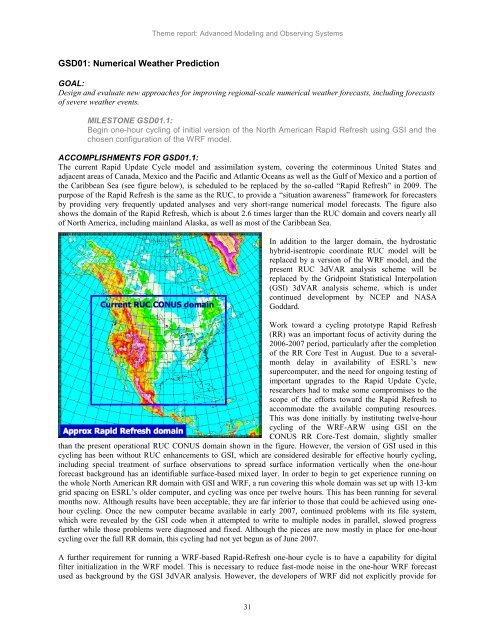Scientific Theme: Advanced Modeling and Observing Systems
Scientific Theme: Advanced Modeling and Observing Systems
Scientific Theme: Advanced Modeling and Observing Systems
Create successful ePaper yourself
Turn your PDF publications into a flip-book with our unique Google optimized e-Paper software.
GSD01: Numerical Weather Prediction<br />
<strong>Theme</strong> report: <strong>Advanced</strong> <strong>Modeling</strong> <strong>and</strong> <strong>Observing</strong> <strong>Systems</strong><br />
GOAL:<br />
Design <strong>and</strong> evaluate new approaches for improving regional-scale numerical weather forecasts, including forecasts<br />
of severe weather events.<br />
MILESTONE GSD01.1:<br />
Begin one-hour cycling of initial version of the North American Rapid Refresh using GSI <strong>and</strong> the<br />
chosen configuration of the WRF model.<br />
ACCOMPLISHMENTS FOR GSD01.1:<br />
The current Rapid Update Cycle model <strong>and</strong> assimilation system, covering the coterminous United States <strong>and</strong><br />
adjacent areas of Canada, Mexico <strong>and</strong> the Pacific <strong>and</strong> Atlantic Oceans as well as the Gulf of Mexico <strong>and</strong> a portion of<br />
the Caribbean Sea (see figure below), is scheduled to be replaced by the so-called ―Rapid Refresh‖ in 2009. The<br />
purpose of the Rapid Refresh is the same as the RUC, to provide a ―situation awareness‖ framework for forecasters<br />
by providing very frequently updated analyses <strong>and</strong> very short-range numerical model forecasts. The figure also<br />
shows the domain of the Rapid Refresh, which is about 2.6 times larger than the RUC domain <strong>and</strong> covers nearly all<br />
of North America, including mainl<strong>and</strong> Alaska, as well as most of the Caribbean Sea.<br />
31<br />
In addition to the larger domain, the hydrostatic<br />
hybrid-isentropic coordinate RUC model will be<br />
replaced by a version of the WRF model, <strong>and</strong> the<br />
present RUC 3dVAR analysis scheme will be<br />
replaced by the Gridpoint Statistical Interpolation<br />
(GSI) 3dVAR analysis scheme, which is under<br />
continued development by NCEP <strong>and</strong> NASA<br />
Goddard.<br />
Work toward a cycling prototype Rapid Refresh<br />
(RR) was an important focus of activity during the<br />
2006-2007 period, particularly after the completion<br />
of the RR Core Test in August. Due to a severalmonth<br />
delay in availability of ESRL‘s new<br />
supercomputer, <strong>and</strong> the need for ongoing testing of<br />
important upgrades to the Rapid Update Cycle,<br />
researchers had to make some compromises to the<br />
scope of the efforts toward the Rapid Refresh to<br />
accommodate the available computing resources.<br />
This was done initially by instituting twelve-hour<br />
cycling of the WRF-ARW using GSI on the<br />
CONUS RR Core-Test domain, slightly smaller<br />
than the present operational RUC CONUS domain shown in the figure. However, the version of GSI used in this<br />
cycling has been without RUC enhancements to GSI, which are considered desirable for effective hourly cycling,<br />
including special treatment of surface observations to spread surface information vertically when the one-hour<br />
forecast background has an identifiable surface-based mixed layer. In order to begin to get experience running on<br />
the whole North American RR domain with GSI <strong>and</strong> WRF, a run covering this whole domain was set up with 13-km<br />
grid spacing on ESRL‘s older computer, <strong>and</strong> cycling was once per twelve hours. This has been running for several<br />
months now. Although results have been acceptable, they are far inferior to those that could be achieved using onehour<br />
cycling. Once the new computer became available in early 2007, continued problems with its file system,<br />
which were revealed by the GSI code when it attempted to write to multiple nodes in parallel, slowed progress<br />
further while those problems were diagnosed <strong>and</strong> fixed. Although the pieces are now mostly in place for one-hour<br />
cycling over the full RR domain, this cycling had not yet begun as of June 2007.<br />
A further requirement for running a WRF-based Rapid-Refresh one-hour cycle is to have a capability for digital<br />
filter initialization in the WRF model. This is necessary to reduce fast-mode noise in the one-hour WRF forecast<br />
used as background by the GSI 3dVAR analysis. However, the developers of WRF did not explicitly provide for
















